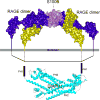Glycation & the RAGE axis: targeting signal transduction through DIAPH1
- PMID: 27967251
- PMCID: PMC5535775
- DOI: 10.1080/14789450.2017.1271719
Glycation & the RAGE axis: targeting signal transduction through DIAPH1
Abstract
The consequences of chronic disease are vast and unremitting; hence, understanding the pathogenic mechanisms mediating such disorders holds promise to identify therapeutics and diminish the consequences. The ligands of the receptor for advanced glycation end products (RAGE) accumulate in chronic diseases, particularly those characterized by inflammation and metabolic dysfunction. Although first discovered and reported as a receptor for advanced glycation end products (AGEs), the expansion of the repertoire of RAGE ligands implicates the receptor in diverse milieus, such as autoimmunity, chronic inflammation, obesity, diabetes, and neurodegeneration. Areas covered: This review summarizes current knowledge regarding the ligand families of RAGE and data from human subjects and animal models on the role of the RAGE axis in chronic diseases. The recent discovery that the cytoplasmic domain of RAGE binds to the formin homology 1 (FH1) domain, DIAPH1, and that this interaction is essential for RAGE ligand-stimulated signal transduction, is discussed. Finally, we review therapeutic opportunities targeting the RAGE axis as a means to mitigate chronic diseases. Expert commentary: With the aging of the population and the epidemic of cardiometabolic disease, therapeutic strategies to target molecular pathways that contribute to the sequelae of these chronic diseases are urgently needed. In this review, we propose that the ligand/RAGE axis and its signaling nexus is a key factor in the pathogenesis of chronic disease and that therapeutic interruption of this pathway may improve quality and duration of life.
Keywords: DIAPH1; Glycation; RAGE; diabetes; inflammation; neurodegeneration; obesity; receptor for AGE.
Conflict of interest statement
The authors have no other relevant affiliations or financial involvement with any organization or entity with a financial interest in or financial conflict with the subject matter or materials discussed in the manuscript apart from those disclosed.
Figures

References
-
- Marinakis E, Bagkos G, Piperi C, Roussou P, Diamanti-Kandarakis E. Critical role of RAGE in lung physiology and tumorigenesis: a potential target of therapeutic intervention? Clin Chem Lab Med. 2014;52:189–200. - PubMed
-
- Gaens KH, Goossens GH, Niessen PM, et al. Nepsilon-(carboxymethyl)lysine-receptor for advanced glycation end product axis is a key modulator of obesity-induced dysregulation of adipokine expression and insulin resistance. Arterioscler Thromb Vasc Biol. 2014;34:1199–1208. This paper describes for the first time the differential expression of RAGE protein in obese and lean human subject adipose tissue. The authors showed that RAGE expression was higher in obese vs. lean human adipose tissue and localized to adipocytes, vascular and immune cells. This work links RAGE to the pathogenesis of obesity. - PubMed
-
- Juranek JK, Daffu GK, Wojtkiewicz J, Lacomis D, Kofler J, Schmidt AM. Receptor for Advanced Glycation End Products and its Inflammatory Ligands are Upregulated in Amyotrophic Lateral Sclerosis. Front Cell Neurosci. 2015;9:485. This paper reports that RAGE and its ligands are highly expressed in the spinal cord of human subjects affected with ALS compared to more basal expression in the normal spinal cord. These studies suggest that the ligands of RAGE are upregulated in chronic disease and lead to the hypothesis that RAGE might contribute to neuronal dysfunction and loss in ALS. - PMC - PubMed
-
- Malik P, Chaudhry N, Mittal R, Mukherjee TK. Role of receptor for advanced glycation end products in the complication and progression of various types of cancers. Biochim Biophys Acta. 2015;1850:1898–1904. - PubMed
-
- Nienhuis HL, Westra J, Smit AJ, Limburg PC, Kallenberg CG, Bijl M. AGE and their receptor RAGE in systemic autoimmune diseases: an inflammation propagating factor contributing to accelerated atherosclerosis. Autoimmunity. 2009;42:302–304. - PubMed
Publication types
MeSH terms
Substances
Grants and funding
LinkOut - more resources
Full Text Sources
Other Literature Sources
Miscellaneous
